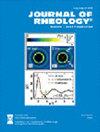Song et al.: Dynamics of dual-junction-functionality associative polymer networks with ion and nanoparticle metal-coordinate cross-link junctions
IF 3.2
2区 工程技术
Q2 MECHANICS
引用次数: 3
Abstract
We provide a canonical introduction to dual-junction-functionality associative polymer networks, which combine high and low functionality ( f) dynamic cross-link junctions to impart load-bearing, dissipation, and self-repairing ability to the network. This unique type of network configuration offers an alternative to traditional dual-junction networks consisting of covalent and reversible cross-links. The high- f junctions can provide load-bearing abilities similar to a covalent cross-link while retaining the ability to self-repair and concurrently confer stimuli-responsive properties arising from the high- f junction species. We demonstrate the mechanical properties of this design motif using metal-coordinating polymer hydrogel networks, which are dynamically cross-linked by different ratios of metal nanoparticle (high- f) and metal ion (low- f) cross-link junctions. We also demonstrate the spontaneous self-assembly of nanoparticle-cross-linked polymers into anisotropic sheets, which may be generalizable for designing dual-junction-functionality associative networks with low volume fraction percolated high- f networks.Song等人:离子和纳米粒子金属配位交联连接的双连接功能缔合聚合物网络的动力学
我们提供了双结功能缔合聚合物网络的规范介绍,它结合了高功能和低功能(f)动态交联结,赋予网络承载、耗散和自我修复能力。这种独特类型的网络结构提供了一种替代传统的由共价和可逆交联组成的双结网络。高f结可以提供类似共价交联的承载能力,同时保留自我修复的能力,并同时赋予高f结物种产生的刺激响应特性。我们使用金属配位聚合物水凝胶网络,通过不同比例的金属纳米粒子(高- f)和金属离子(低- f)交联结动态交联,展示了该设计motif的力学性能。我们还证明了纳米颗粒交联聚合物的自发自组装成各向异性薄片,这可以推广到设计具有低体积分数渗透的高f网络的双结功能缔合网络。
本文章由计算机程序翻译,如有差异,请以英文原文为准。
求助全文
约1分钟内获得全文
求助全文
来源期刊

Journal of Rheology
物理-力学
CiteScore
6.60
自引率
12.10%
发文量
100
审稿时长
1 months
期刊介绍:
The Journal of Rheology, formerly the Transactions of The Society of Rheology, is published six times per year by The Society of Rheology, a member society of the American Institute of Physics, through AIP Publishing. It provides in-depth interdisciplinary coverage of theoretical and experimental issues drawn from industry and academia. The Journal of Rheology is published for professionals and students in chemistry, physics, engineering, material science, and mathematics.
 求助内容:
求助内容: 应助结果提醒方式:
应助结果提醒方式:


